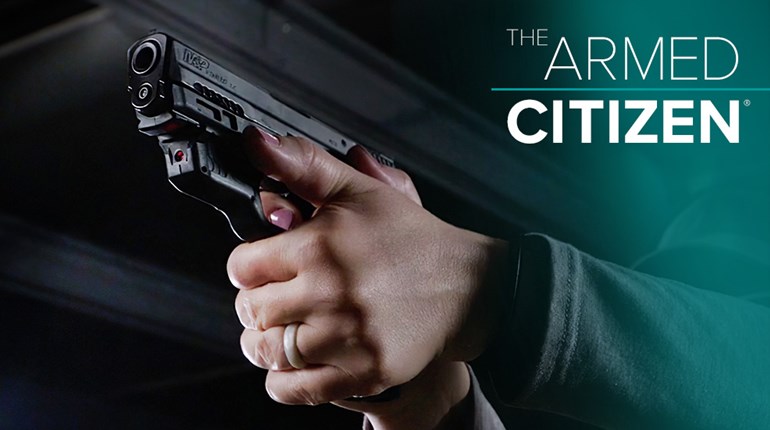
I was brought up quail hunting, where I was taught to never aim a shotgun. As it turns out, there are plenty of times when a shotgun should be aimed—one of them is in the home, where ranges are measured in feet and patterns are measured in inches. However, shotguns are still predominantly designed for wingshooters, and that’s the reason most factory shotguns come with a non-adjustable front bead. The bead is meant only as a reference while focusing on a distant target, and most shotguns come without rear sights at all. This doesn’t mean your front-bead-only shotgun won’t work well for home defense—it will—but it also doesn’t mean you can assume point-of-aim (POA)/point-of-impact (POI) alignment is dead-on. You should check it before depending on it to save your life—just like any sights.
A line must have at least two points, and it’s the same with line-of-sight. So, if your shotgun only has one bead for a sight and no rear apparatus by which to align it, your eye becomes that second point by default and, therefore, must remain in the exact same place relative to the bead from shot to shot. If you don’t consistently weld your cheek to the stock, accuracy will suffer. Recreational shotgunners rarely worry about this, because at distance a shotgun’s spread negates slight disparities in POA/POI. Additionally, guns were built with full-contour stocks that would naturally align the eye directly down the rib of the gun to facilitate consistent alignment.
But, times have changed. Some new AR-influenced tactical stock designs force shooters to keep their heads up off the stock to shoot, inviting inconsistency. Others are so uncomfortable shooters subconsciously raise their cheek off it to avoid pain. Likewise, aftermarket sight systems sold on tactical guns can arrive off from the factory. So, the first thing you should do with your home-defense shotgun is not assume it’s dead-on. Instead, grab the loads you plan to use for self-defense and hit the range.
From a standing position 7 yards away, aim at a cardboard target with a quarter-size bullseye in the middle. Shoulder the shotgun naturally as if in a real defensive situation. Be careful not to flinch or slap the trigger. Shoot the shotgun as if it were a rifle. Then shoot several more times at the same target to find your average point-of-impact. Don’t shoot from a benchrest, as doing so can invite unnatural shooting positions and skew results.
If the pattern’s center is within a couple inches of the bullseye (your POA), you’re good to go. But if it’s off, you have several options. If it’s a name-brand shotgun and it’s off by more than 6 inches, consider calling the manufacturer, as the gun is likely defective. But first, verify by having an experienced friend shoot it, too. If it’s only slightly off zero, measure the POI relative to your POA. If your shotgun has adjustable sights or an optic, make the necessary corrections. But if it only has a front bead or the sights are non-adjustable, follow these steps.
If your point-of-impact is low and you need to raise it, you either need to raise your eye consistently while aiming the bead, or consider buying an optic or adjustable sights. (Lowering or filing a small front bead is usually not feasible.) If you buy adjustable sights, make sure they are robust and not thin metal or plastic, as I can’t count the number of times these cheap fiber-optic sights have failed during routine use.
In order to raise your head and eye consistently, check if your shotgun came with interchangeable shims to adjust stock fit. Plenty do nowadays, including Benelli, Remington and Beretta variants, among others. The basic rule of thumb is that a 1⁄16-inch stock adjustment will result in a 1-inch POI shift at 16 yards. If you have shims, use them. If that’s not enough, consider installing an aftermarket cheek pad like Beretta’s Gel Tec Cheek Protector. It sticks on and is available in various thicknesses. Before purchasing, experiment by taping cardboard shims to the stock’s comb to see if it fixes the problem.
If your POI is high and you need to lower it, first make sure that you’re shooting with your face tightly against the stock. Next, if your gun came with stock shims, install one that results in more drop at comb. If you have no shims, consider buying a taller aftermarket front sight like that from XS Sight Systems.
If your point-of-impact is left or right, you’ll most likely need to install aftermarket sights or an optic, since most guns suitable for home defense do not come with target-style stocks that are adjustable for cast-on and cast-off. (A few of the shim kits include one shim for cast adjustment.) But before doing so, have a friend observe you to make sure you are aligning your gun shoulder-side eye directly in line with the shotgun’s rib and not off to one side.
Nine times out of 10, your bead sight will be close enough for duty right out of the box, and I prefer them for home defense over ghost rings or optics due to their inherent speed and simplicity. Most beads are perfectly accurate, cannot be knocked out of alignment, don’t depend on batteries and don’t overly impede vision. Whatever you go with, know that your shotgun prints to your point-of-aim before trusting it with your life.




































